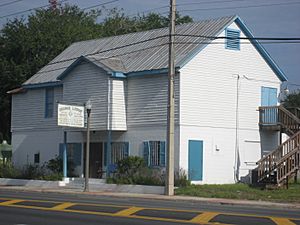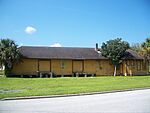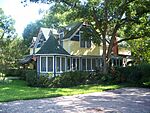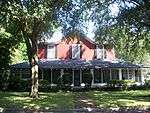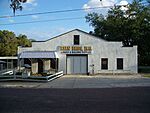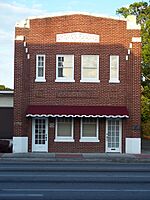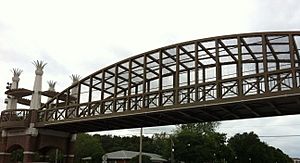Apopka, Florida facts for kids
Quick facts for kids
Apopka
|
|||
|---|---|---|---|
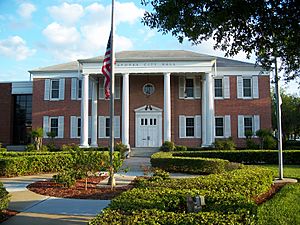
Apopka City Hall in April 2007
|
|||
|
|||
| Nickname(s):
Indoor Foliage Capital of the World
|
|||
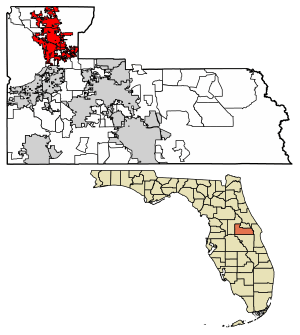
Location of Apopka in Orange County, Florida.
|
|||
| Country | United States | ||
| State | Florida | ||
| County | Orange | ||
| Incorporated (Town of Apopka City) |
1882 | ||
| Incorporated (City of Apopka) |
1919 | ||
| Government | |||
| • Type | Mayor–Commission | ||
| Area | |||
| • Total | 35.97 sq mi (93.17 km2) | ||
| • Land | 34.59 sq mi (89.60 km2) | ||
| • Water | 1.38 sq mi (3.58 km2) 4.07% | ||
| Elevation | 82 ft (25 m) | ||
| Population
(2020)
|
|||
| • Total | 54,873 | ||
| • Density | 1,586.25/sq mi (612.44/km2) | ||
| Demonym(s) | Apopkan | ||
| Time zone | UTC−5 (EST) | ||
| • Summer (DST) | UTC−4 (EDT) | ||
| ZIP codes |
32703, 32704, 32712
|
||
| Area codes | 321, 407, 689 | ||
| FIPS code | 12-01700 | ||
| GNIS feature ID | 2403103 | ||
Apopka is a city in Orange County, Florida. The city's population was 54,873 at the 2020 census. It is part of the Orlando–Kissimmee–Sanford Metropolitan Statistical Area. Apopka comes from Seminole word Ahapopka for "potato-eating place".
Apopka is referred to as the "Indoor Foliage Capital of the World" due to the many greenhouse nurseries there.
Contents
History
The earliest known inhabitants of the Apopka area were the Acuera people, members of the Timucua confederation. They had disappeared by 1730, probably decimated by diseases transmitted through Florida by Spanish colonists.
The Acuera were succeeded by refugees from Alabama and Georgia, who formed the new Seminole Indian tribe. They called the area Ahapopka. Aha, meaning "Potato," and papka, meaning "eating place". By the 1830s, this settlement numbered about 200, and was the birthplace of the chief Coacoochee (known in English as "Wild Cat").
At the conclusion of the Second Seminole War, the U.S. Congress passed the Armed Occupation Act of 1842, forcing surviving natives at Ahapopka to abandon their village and seek refuge deeper in the wilderness of the Florida peninsula.
The early American settlers built a major trading center on the foundations of the earlier Indian settlement. Their population was large enough by 1857 to support the establishment of a Masonic lodge. In 1859 the lodge erected a permanent meeting place at what is now the intersection of Main Street (U.S. Highway 441) and Alabama Avenue.
The Lodge
The settlers in the vicinity of "The Lodge" were largely isolated during the Civil War, but the area rebounded once peace was re-established, and a population boom followed the construction of railroad lines through the region.
In 1869, the Apopka Post Office opened.
Town of Apopka City
In 1882, the one mile in each direction of "The Lodge" or "Fudge Hall" was officially incorporated under the name "Town of Apopka City". In the 1890s, the town was contracted in size more than once due to difficult times.
In 1905, the Apopka City Council authorized incorporation of the Apopka Water, Light, and Ice Company. Councilman A.M. Starbird was appointed its manager, but it was not until voters approved a $9,000 bond in 1914 that he was able to contract with International Harvester Corporation to construct a power plant, so electricity was not available in the city until February 10, 1915. This independent utility company was one of many that were acquired by the Florida Public Service Corporation in the 1920s. They continued to manage the city's utility needs until the 1940s, when they sold off its ice plants to the Atlantic Company, its electric service to Florida Power Corporation, and its water services to Florida Utilities.
Between 1937 and 1968 a town ordinance forbade Black residents from living north of the railroad tracks.
Historic buildings
Five buildings in Apopka have been placed on the U.S. National Register of Historic Places through the Apopka Historical Society housed in the Museum of the Apopkans.
Present-day Apopka
Apopka is known for having one of the longest-serving mayors in the United States. John H. Land, first elected in 1949, served for over 61 years (with a short three-year gap), making him the longest-serving mayor in Florida and longest-serving full-time mayor in the United States through 2014. Apopka is served by the Apopka Police Department within city limits and the Orange County Sheriff's Department for unincorporated Apopka.
On April 8, 2014, Apopka City Commissioner Joe Kilsheimer won the election to succeed John H. Land as mayor. Kilsheimer was sworn in on April 22, 2014. The 2018 primary for mayor resulted in a landslide win for Bryan Nelson with 63.40% (4,103) of the vote to Kilsheimer's 36.6% (2,369). No runoff was required.
Mayors of the City of Apopka
| Mayor | First Year |
Term of Years |
Total Years |
Mayor | First Year | End Year | Term of Years |
Total Years |
|---|---|---|---|---|---|---|---|---|
| James Daniel Fudge | 1882 | 3 | John Jewell | 1926 Jan | 1930 Dec | 5 | ||
| Jessse J. Combs | 1885 | 1 | Edward J. Ryan | 1931 Jan | 1934 Dec | 3 | ||
| Page McKinney | 1886 | 2 | Gillen McClure | 1935 Jan | 1937 Dec | 3 | ||
| Dr. Horatio S. Brewer | 1888 | 5 | Mark V. Ryan | 1938 Jan | 1940 Dec | 3 | ||
| R. C. Waters | 1893 | 2 | Leslie P. Waite | 1941 Jan | 1946 Dec | 6 | ||
| E. A. Jackson | 1895 | 1 | Dr. Charles Henry Damsel | 1947 Jan | 1949 Dec | 3 | ||
| Andrew Jackson Lovell | 1896 | 9 | * | John Horting Land | 1950 Jan | 1967 Dec | 18 | * |
| Joseph D Mitchill | 1905 | 7 | * | Leonard Hurst | 1968 Jan | 1970 Dec | 3 | |
| Adelbert M. Starbird | 1912 | 1 | John Horting Land | 1971 Jan | 2014 Mar | 43.25 | 61.25 | |
| Andrew Jackson Lovell | 1913 | 1 | 10 | Joe Kilsheimer | 2014 Apr | 2018 | 4 | |
| Walter R. McLeod | 1914 | 1 | Bryan Nelson | 2018 Apr 24 | 2026 | 8 | ||
| Frank Davis | 1915 | 1 | ||||||
| Walter Newell | 1916 | 2 | * | |||||
| Thomas B. Tower | 1918 | 1 | ||||||
| Walter P. Newell | 1919 | 1 | 3 | |||||
| Joseph D Mitchill | 1920 | 3 | 10 | |||||
| Edward Barker Morrey | 1923 | 3 |
- An asterisk indicates discontiguous terms of service.
- 1882 to 1923 elections were held annually. Then every three years. Then four years as the city election codes were changed.
Development
Apopka is a fast-growing city and is expanding in all directions. Most notable are the new stores to the north of the city on US 441 in the location of the previous Dunn Citrus grove (the stretch of 441 which runs through the city is named after Fred N. Dunn). Due to the fast-paced growth of the city, a new hospital, AdventHealth Apopka, was opened in 2017.
The John Land Apopka Expressway (Toll 414) opened on May 15, 2009, relieving some of US 441's traffic, taking the route from what is now the US 441 junction with SR 429, and then passing south of the city to rejoin US 441 at its junction with Maitland Boulevard South of the city.
Expansion of the expressway, including an extension of Toll 414, known as Wekiva Parkway, created a junction at US 441 and Plymouth Sorrento Road. Master plans take the Wekiva Parkway extension further north and then east connecting to Interstate 4 at Sanford. The expansion is scheduled to be completed by 2023. It will then be the shortest route from I-4 to the Disney attractions.
Geography
The approximate coordinates for the City of Apopka is located at 28°42′06″N 81°31′54″W / 28.70167°N 81.53167°W.
Apopka is about 16 miles northwest of Downtown Orlando.
According to the United States Census Bureau, the city has a total area of 32.6 square miles (84.4 km2). 31.2 square miles (80.9 km2) of it is land and 1.4 square miles (3.5 km2) of it (4.15%) is water.
Climate
The climate in this area is characterized by hot, humid summers and generally mild winters. According to the Köppen climate classification, the City of Apopka has a humid subtropical climate zone (Cfa).
| Climate data for Plymouth 3N, 2002–2015 normals, extremes 2002–present | |||||||||||||
|---|---|---|---|---|---|---|---|---|---|---|---|---|---|
| Month | Jan | Feb | Mar | Apr | May | Jun | Jul | Aug | Sep | Oct | Nov | Dec | Year |
| Record high °F (°C) | 86 (30) |
88 (31) |
92 (33) |
96 (36) |
98 (37) |
100 (38) |
98 (37) |
99 (37) |
97 (36) |
96 (36) |
91 (33) |
87 (31) |
100 (38) |
| Mean daily maximum °F (°C) | 70.2 (21.2) |
72.1 (22.3) |
78.5 (25.8) |
83.4 (28.6) |
88.6 (31.4) |
90.9 (32.7) |
92.0 (33.3) |
92.2 (33.4) |
89.8 (32.1) |
84.8 (29.3) |
76.9 (24.9) |
72.0 (22.2) |
82.6 (28.1) |
| Mean daily minimum °F (°C) | 41.8 (5.4) |
44.3 (6.8) |
50.0 (10.0) |
54.8 (12.7) |
62.5 (16.9) |
69.6 (20.9) |
71.7 (22.1) |
72.3 (22.4) |
69.5 (20.8) |
60.9 (16.1) |
51.1 (10.6) |
45.4 (7.4) |
57.8 (14.3) |
| Record low °F (°C) | 16 (−9) |
19 (−7) |
26 (−3) |
30 (−1) |
45 (7) |
57 (14) |
65 (18) |
63 (17) |
54 (12) |
32 (0) |
28 (−2) |
15 (−9) |
15 (−9) |
| Average precipitation inches (mm) | 2.51 (64) |
2.56 (65) |
3.01 (76) |
3.02 (77) |
4.03 (102) |
7.95 (202) |
7.15 (182) |
8.36 (212) |
4.75 (121) |
2.80 (71) |
1.47 (37) |
2.71 (69) |
50.32 (1,278) |
| Average rainy days (≥ 0.01 in) | 7.2 | 6.9 | 6.9 | 5.1 | 7.8 | 16.0 | 16.5 | 17.8 | 11.9 | 7.3 | 4.5 | 7.0 | 114.9 |
| Source: NOAA | |||||||||||||
Demographics
| Historical population | |||
|---|---|---|---|
| Census | Pop. | %± | |
| 1890 | 490 | — | |
| 1900 | 218 | −55.5% | |
| 1910 | 410 | 88.1% | |
| 1920 | 798 | 94.6% | |
| 1930 | 1,134 | 42.1% | |
| 1940 | 1,312 | 15.7% | |
| 1950 | 2,254 | 71.8% | |
| 1960 | 3,578 | 58.7% | |
| 1970 | 4,045 | 13.1% | |
| 1980 | 6,019 | 48.8% | |
| 1990 | 13,512 | 124.5% | |
| 2000 | 26,642 | 97.2% | |
| 2010 | 41,542 | 55.9% | |
| 2020 | 54,873 | 32.1% | |
| U.S. Decennial Census | |||
2010 and 2020 census
| Race | Pop 2010 | Pop 2020 | % 2010 | % 2020 |
|---|---|---|---|---|
| White (NH) | 20,553 | 20,860 | 49.48% | 38.02% |
| Black or African American (NH) | 8,147 | 13,615 | 19.61% | 24.81% |
| Native American or Alaska Native (NH) | 69 | 86 | 0.17% | 0.16% |
| Asian (NH) | 1,309 | 1,666 | 3.15% | 3.04% |
| Pacific Islander or Native Hawaiian (NH) | 19 | 28 | 0.05% | 0.05% |
| Some other race (NH) | 147 | 456 | 0.35% | 0.83% |
| Two or more races/Multiracial (NH) | 750 | 2,191 | 1.81% | 3.99% |
| Hispanic or Latino (any race) | 10,548 | 15,971 | 25.39% | 29.11% |
| Total | 41,542 | 54,873 |
As of the 2020 United States census, there were 54,873 people, 17,312 households, and 12,822 families residing in the city.
As of the 2010 United States census, there were 41,542 people, 14,739 households, and 10,648 families residing in the city.
Education
- Forest Lake Academy, a Seventh-day Adventist high school.
- Apopka is served by Orange County Public Schools with two high schools: Apopka High School and Wekiva High School.
- University of Florida's Institute of Food and Agricultural Sciences Mid-Florida Research and Education Center is located in Apopka.
- The Golf Academy of America (Altamonte Campus), a 2-year golf college is located in Apopka.
- Christian Learning Academy is a private K–12 school offering varsity athletics, music programs, and Model United Nations.
Healthcare
There is only one hospital in Apopka: AdventHealth Apopka.
Notable people
Automobile racing
- Fireball Roberts, race car driver
- Wayne Taylor, owner, Wayne Taylor Racing; winner of 1996 and 2005 24 Hours of Daytona, 2005 Rolex Series
Baseball
- Ray Goolsby (war veteran) Washington Senators in Chattanooga, TN
- Zack Greinke, Baseball All-Star (2009, 2014), MLB ERA leader (2009), Gold Glove Award (2014), Silver Slugger Award (2013) and 2009 AL Cy Young Award winner
Basketball
- Joel Berry II, basketball player for the University of North Carolina
- Joe Chealey, Basketball Player
Economics
- Glenn Hubbard, dean, Columbia University Graduate School of Business
Arts
- Brad Linaweaver, science fiction writer, film producer and screenwriter, magazine publisher
Football
- Steve Baylark, NFL running back
- Rogers Beckett Jr., former NFL safety for the San Diego Chargers and the Cincinnati Bengals
- Alan Gendreau, football placekicker at Middle Tennessee State
- Brandon Meriweather, former NFL defensive back
- Jalen Carter, Philadelphia Eagles Defensive Tackle
- Warren Sapp, All-Pro NFL defensive lineman
- Sammie Smith, former NFL running back for the Miami Dolphins and the Denver Broncos
- Renardo Green, Cornerback for the San Francisco 49ers.
Gaming
- Justin McGrath, professional Super Smash Bros. Melee player
Infamous
- Michael Larson, Press Your Luck Scandal winner of $110,237 in 1984
Inventor
- Richard Borg, board game designer
Music
- Scott Stapp, member of multi mega hit rock group Creed, singer and songwriter grew up in Apopka
- John Anderson, country singer
- Sawyer Brown, country music band founded in Apopka
- Jonathan Cain, member of multi mega hit rock group Journey, multi-instrumentist and songwriter resides in Apopka
- Jerry Lawson, lead singer of The Persuasions
- Pat Travers tours from, records, and resides in Apopka
Boxing, weightlifting, and wrestling
- Christy Martin, American world champion boxer, resided in Apopka for many years and operated a boxing school
- Mattie Rogers, Olympic Weightlifter
- Monty Sopp, professional wrestler, former WWF/E
Apopka in art
Literature
Apopka is referenced in Zora Neale Hurston's famous novel, Their Eyes Were Watching God.
Apopka is referenced in Eddie C. Brown's autobiographical book, Beating the Odds: Eddie Brown's Investing and Life Strategies.
History of the greater Apopka and Central Florida area is detailed in William Gladden, Jr's book, The Pennings of Perrine Slim: Stories of Northwest Orange County Florida. Included are 100 pictures of the area, most by Dr Phyllis Olmstead. Olmstead Publishing.
History of Apopka and Northwest Orange County, Florida by Jerrell H Shofner, (1982). Rose Printing. Apopka Historical Society.
Tales of the Big Potato by Jack Christmas (2011). New Book Publishing. Reprint Olmstead Publishing.
Apopka: Images of America photos of the Apopka area, (2004). Apopka Historical Society.
Film
Apopka takes place in and is prominently featured in Johannes Grenzfurthner's horror drama Masking Threshold that premiered at Fantastic Fest in 2021.
Apopka is referenced in "" Ernest Saves Christmas"" on Ernest's truck "Apopka Snake Ranch"
See also
 In Spanish: Apopka para niños
In Spanish: Apopka para niños




